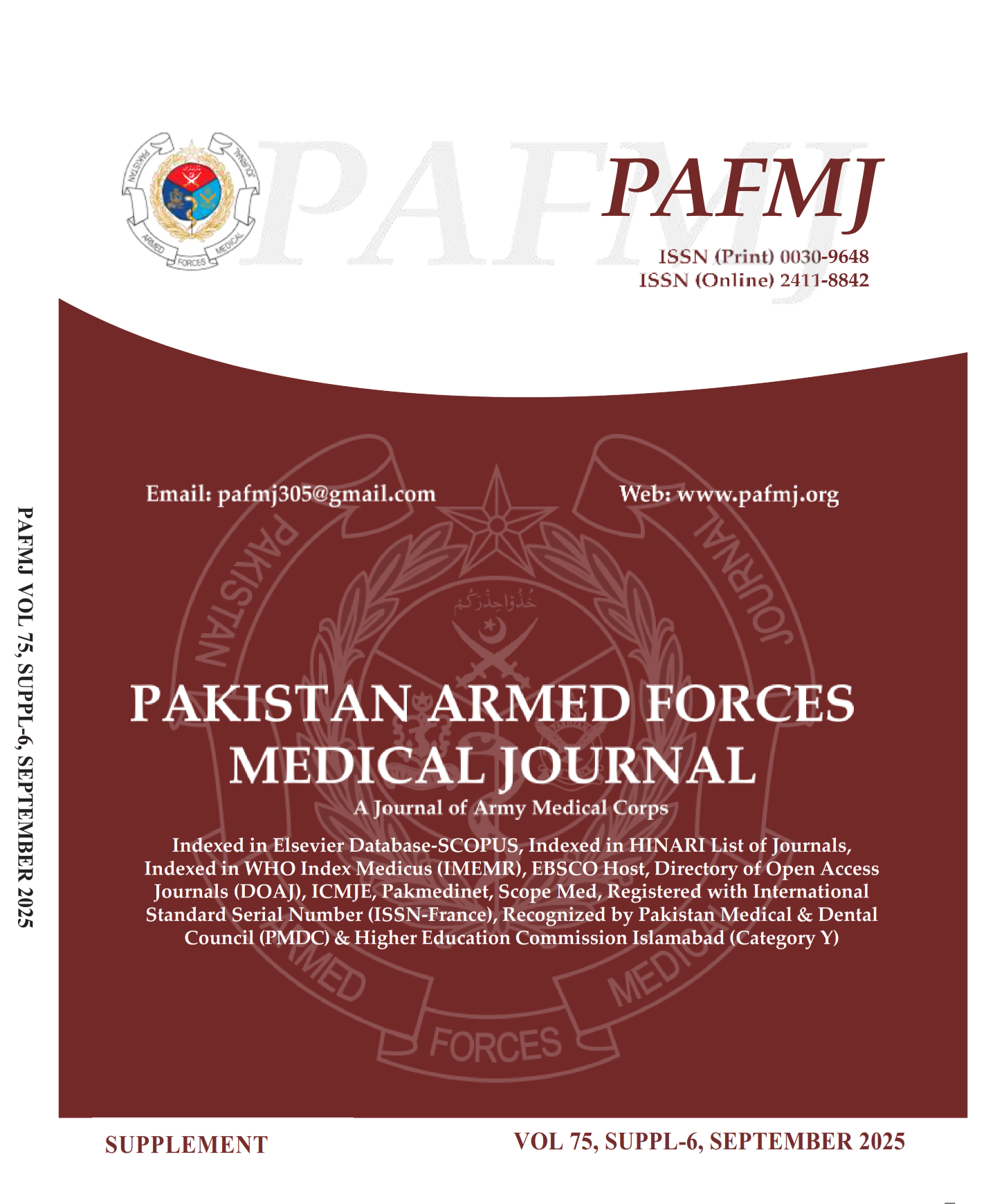Arterial Cannulation in Neonates: A Comparison Between Real-Time Ultrasound-Guidance and Palpation Technique
DOI:
https://doi.org/10.51253/pafmj.v75iSUPPL-6.7740Keywords:
Arterial Cannulation, Neonates, Ultrasonography.Abstract
Objective: Arterial cannulation is a useful skill for doctors working in anaesthesiology and critical care. In paediatrics, arterial cannulation is arduous due to the small calibre of artery. In neonates, it becomes even more challenging. In this study, we compared the success of real-time ultrasound guided arterial cannulation with that of traditional palpation technique.
Study Design: Prospective Comparative Study.
Place and Duration of Study: Pak Emirates Military Hospital, Rawalpindi Pakistan, from Jul 2020 to Oct 2021.
Methodology: We included eighty neonates scheduled for major surgery under general anaesthesia. They were divided randomly into two Groups, each Group comprising 40 patients. In ‘Group A’ arterial cannulation was performed using real-time ultrasound guidance while in ‘Group B’ palpation technique was used. The primary outcome of our study was number of attempts until successful arterial cannulation. Secondary outcome of study was number of complications (thrombosis, haematoma).
Results: In this study, a total of 80 neonates were enrolled. There was no difference in demographic data comparison. First attempt success rate in imaging Group was considerably higher 33(82.5%) versus 21(52.5%) with p-value of <0.001. Neonates in ultrasound Group required a smaller number of attempts (1.38±1.005) than in palpation Group (4.00±1.396) for successful cannulation (p-value<0.001).
Conclusion: We concluded that real-time ultrasonography guidance is more successful than palpation technique for arterial cannulation.
Downloads
References
1. Aouad M, Raphael CK, Sayyid, SK. Ultrasound-guided arterial cannulation for paediatrics. Cochrane Database Syst Rev 2016; 9: 1-44.
2. Polat TB. Ultrasound-Guided Femoral Arterial Cannulation in Neonates Undergoing Cardiac Surgery or Catheterization: Comparison of 0.014-Inch Floppy Versus 0.019-Inch Straight Guidewire, Pediatr Crit. CareMed 2019; 20(7): 608-613.
3. Salık F, Bıçak M. Comparison of ultrasound-guided femoral artery cannulation versus palpation technique in neonates undergoing cardiac surgery. J Vasc Access 2021.
https://doi.org/10.1177/11297298211023307
4. Marquis G, Tremblay G, M, Lévesque, J. Ultrasound guidance versus anatomical landmark approach for femoral artery access in coronary angiography: a randomized controlled trial and a meta-analysis. J Interv Cardiol 2018; 3194): 496–503.
5. Siddik-Sayyid, SM, Aouad, MT, Ibrahim, MH, et al. Femoral arterial cannulation performed by residents: a comparison between ultrasound-guided and palpation technique in infants and children undergoing cardiac surgery. Paediatr Anaesth 2016; 26(8): 823–830.
6. Oulego-Erroz, I, Mayordomo-Colunga, J, González-Cortés, R. Ultrasound-guided arterial cannulation or by pulse palpation in the intensive care unit. An Pediatría 2021; 94(3): 144–152.
7. McGahan JP. The history of interventional ultrasound. J Ultrasound Med 2004; 23(6): 727-741.
https://doi.org/10.7863/jum.2004.23.6.727
8. Deindl, P, Waldhor T, Unterasinger L, Berger K, Keck M. Arterial catheterisation in neonates can result in severe ischaemic complications but does not impair long-term extremity function. Acta Paediatrica 2018; 107(2): 240-248.
9. Min JJ, Tay CK, Gil NS, Lee GH, Kim S, Kim CS. Ultrasound-guided vs. palpation-guided techniques for radial arterial catheterisation in infants: A randomised controlled trial. Eur J Anaesthesiol 2019; 36(3): 200-205.
10. Tan TYS, Petersen JAK, Zhao XTK. Randomized controlled trial of ultrasound versus palpation method for arterial cannulation in infants less than 24 months of age. SOJ Anesthesiol Pain Manag 2015; 2(2): 1–3.
11. Stone, P, Campbell, J, Thompson, S, et al. A prospective, randomized study comparing ultrasound versus fluoroscopic guided femoral arterial access in noncardiac vascular patients. J Vasc Surg 2020; 72(1): 259–267.
12. Bodenham A, Babu S, Bennett J. Association of Anaesthetists of Great Britain and Ireland: safe vascular access 2016. Anaesthesia. 2016; 71(5): 573–585.
13. Staudt, GE, Eagle, SS, Hughes, AK. Evaluation of dynamic ultrasound for arterial access in children undergoing cardiac surgery. J Cardiothorac Vasc Anesth 2019; 33(7): 1926–1929.
14. Hansen MA, Juhl-Olsen P, Thorn S, Frederiksen CA, Sloth E. Ultrasonography-guided radial artery catheterization is superior compared with the traditional palpation technique: a prospective, randomized, blinded, crossover study. Acta Anaesthesiol Scand 2014; 58(4): 446–452.
15. Ishii S, Shime N, Shibasaki M. Ultrasound-guided radial artery catheterization in infants and small children. Pediatr Crit Care Med 2013; 14(5): 471-473.
16. Ueda K, Puangsuvan S, Hove MA, Bayman EO. Ultrasound visual image-guided vs Doppler auditory-assisted radial artery cannulation in infants and small children by non-expert anaes- thesiologists: a randomized prospective study. Br J Anaesth 2013; 110(2): 281–286.
17. Gopalasingam N, Hansen MA, Thorn S, Sloth E, Juhl-Olsen P. Ultrasound-Guided Radial Artery Catheterisation Increases the Success Rate among Anaesthesiology Residents: A Randomised Study. J Vasc Access 2017; 18(6): 546-551.
18. Arnold H. Seto, Jonathan S. Roberts, Mazen S. Real-Time Ultrasound Guidance Facilitates Transradial Access: RAUST (Radial Artery Access with Ultrasound Trial). JACC.Cardiovasc Interv 2015; 8(2): 283-291.
19. Gottlieb M, Sundaram T, Holladay D, Nakitende D. Ultrasound-Guided Peripheral Intravenous Line Placement: A Narrative Review of Evidence-based Best Practices. West J Emerg Med 2017: 18; 1047-1054.
Downloads
Published
Issue
Section
License
Copyright (c) 2025 Azmat Riaz, Kaukab Majeed, Amran Hafiz, Usman Ejaz Malik, Syed Ali Mazhar Rizvi, Nabeel Tahir Butt

This work is licensed under a Creative Commons Attribution-NonCommercial 4.0 International License.















